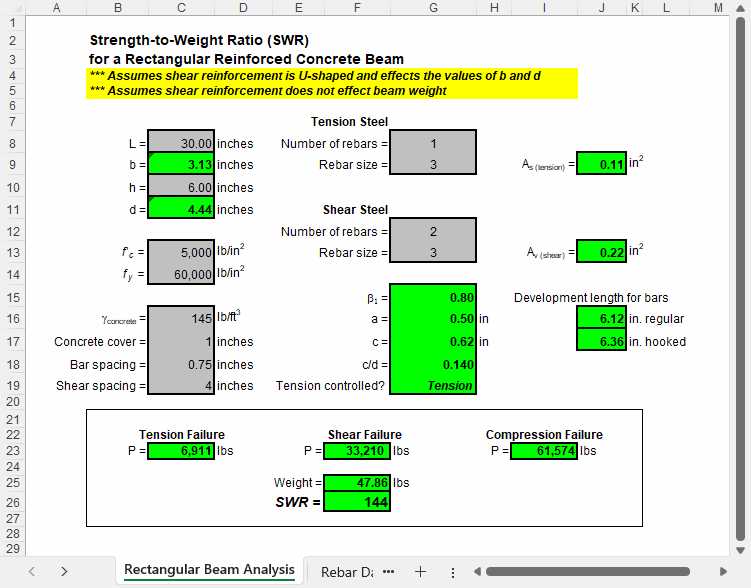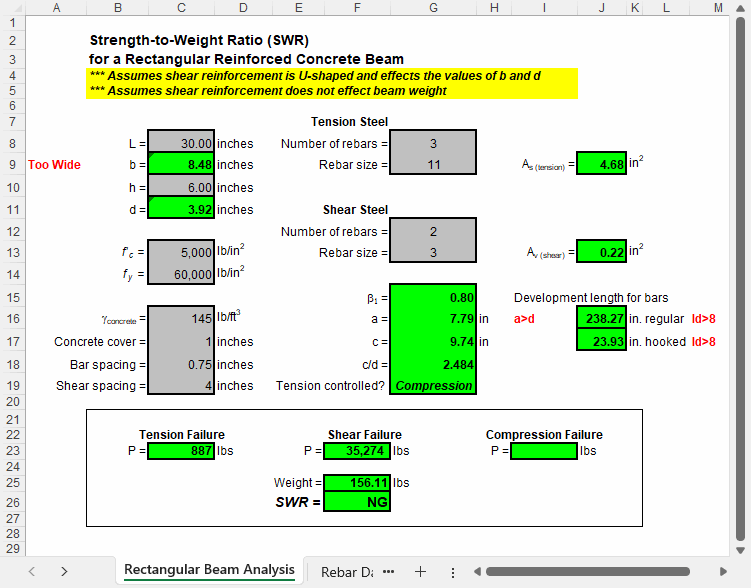|
"If you can't explain something simply, you don't know enough
about it." - Albert Einstein (1879 - 1955)
Objective
The purpose of this assignment is twofold: first, to further develop
your engineering spreadsheet skills, and second, to develop analysis tools that will
complement your
concrete beam design project. Assignment #7 should
complement and enhance capabilities of the spreadsheet you developed in
Assignment #6.
You must hand in the cover
sheet for the assignment, printouts of
your spreadsheet for Parts 1 and 2. Also, submit
your spreadsheets for Parts 1 and 2 to Canvas. You
must follow the Excel format.
Part 1: Develop a spreadsheet to predict the strength-to-weight ratio
(SWR) of rectangular reinforced concrete beams subjected to tension and shear forces.
Input parameters should include the height and length of the beam, the amount
of reinforcement (both tension and shear), the compressive strength of the concrete, the yield stress of the
reinforcement, the unit weight of the concrete, the minimum concrete cover for the
reinforcement, the minimum spacing between rebars, and the shear reinforcement spacing.
From these inputs, you should compute the minimum width of the beam,
the depth to the center of the reinforcement, the area of steel in As
in both tension and shear, the b1 constant,
depth to the neutral axis, the moment
capacity, the ultimate force due to both tension and shear, the weight of the beam, and the SWR. Verify
whether the given reinforcement allows the beam to be controlled by tension,
compression, or is in the transitional zone (see
class notes).
Also, compute the development length of regular and hooked reinforcing bars.
Click
here for a template copy of the
following rectangular
reinforced concrete beam analysis spreadsheet.

Based on the value c/d, determine whether the beam is controlled
by tension or compression, or is in a transitional area. The
predictive value for P is the minimum of the tension, shear, and compression
values.
If a > d, then write "a>d"
next to the cell and write "NG" in the SWR cell.
If the required width of the beam is computed from the concrete cover,
the diameter of the tension rebars, and rebar spacing is greater than 8 inches, then write
"Too Wide"
next to the beam width cell.
If the development length is
greater than 8 in. then then write "ld>8"
next to the cells.
An example of conditions that fail to satisfy the rebar yielding
and spacing conditions is shown below.

Predict the SWR for the reinforced concrete beam in the sample
interface sheets above.
Part 2: Use your spreadsheet to
determine the nominal flexural strength and SWR of the rectangular section given: L = 30
inches, h = 6 inches, f'c = 7,000 psi, fy = 60,000 psi,
As = one #4 bars in tension, one #3 rebar in shear, concrete cover = 1
inch, tension bar spacing = 1 inch, and shear bar spacing = 2 inches.
Requirements
Lastly, a web page describing the CIVL 1112
homework
policy is available. Read it before you turn in this assignment. You will be graded
throughout the semester according to the policy outlined in it.
Cover sheet for homework
This website was originally
developed by
Charles Camp for
CIVL
1112.
This site is maintained by the
Department of Civil Engineering
at the University of Memphis.
Your comments and questions are welcomed.
|





